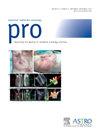Single Fraction Radiosurgical Tolerance of Brainstem, Trigeminal Nerve, and Meckel's Cave for Facial Numbness
IF 3.4
3区 医学
Q2 ONCOLOGY
引用次数: 0
Abstract
Purpose
This article reviews toxicity outcomes for a series of patients treated with stereotactic radiosurgery for trigeminal neuralgia, focusing on dose to the brainstem, trigeminal nerve, and Meckel's cave as possible explanatory variables for the development of the most common posttreatment neuropathy, facial numbness.
Methods and Materials
A retrospective review of 136 cases treated with CyberKnife radiosurgery for trigeminal neuralgia was performed. Dose was initially (cohort 1) prescribed to 57 to 64 Gy covering a 6-mm cylindrical shaped target volume ≥2 mm from the dorsal root entry zone. Subsequently, a deliberate change to isocentric treatment planning occurred, resulting in delivery of 85 Gy to a spherical target (cohort 2). Brainstem, trigeminal nerve, and Meckel's cave were contoured, and a variety of dosimetric and clinical factors were analyzed for association with development of treatment-related facial numbness.
Results
Treatment-related numbness occurred in 59 of 136 (43%) patients and did not differ between the treatment cohorts. Fifty-two patients experienced Barrow Neurological Institute (BNI) grade II toxicity, and 7 patients experienced BNI grade III toxicity. Time to numbness was 16.0 months for cohort 1 and 10.4 months for cohort 2 (P = .184). The median brainstem maximum dose was 26.1 Gy, ranging from 4.2 Gy to 57.3 Gy. Maximum dose to the trigeminal nerve was 85 Gy. Mean trigeminal nerve dose was 47.3 Gy. The median Meckel's cave maximum and mean doses were 26.0 Gy and 6.8 Gy, respectively. No definitive upper limit dose threshold was detected for the structures analyzed, but trends were noted for maximum trigeminal nerve dose of 85 Gy (P = .083) and for prescription dose (P = .057) and trigeminal nerve V40 (P = .077) in the type I subset.
Conclusions
Brainstem, trigeminal nerve, and Meckel's cave tolerated doses within the range delivered. Discussion of the literature is provided to guide treatment planning and management.
针对面部麻木的脑干、三叉神经和梅克尔洞的单部分放射手术耐受性。
导言:本文旨在回顾立体定向放射手术(SRS)治疗三叉神经痛的一系列患者的毒性结果,重点关注脑干、三叉神经和梅克尔凹的剂量,将其作为治疗后最常见的神经病变--面部麻木的可能解释变量:对136例使用赛博刀放射外科手术治疗三叉神经痛的病例进行了回顾性研究。最初(群组 1)规定的剂量为 57 至 64 Gy,覆盖 6 毫米圆柱形靶区,距离背根进入区(DREZ)至少 2 毫米。随后,治疗计划有意改为等中心治疗,结果向球形靶点投放了 85 Gy 的剂量(队列 2)。对脑干、三叉神经和梅克尔凹进行了轮廓分析,并分析了各种剂量测定和临床因素与治疗相关面部麻木的关系:59/136(43%)名患者出现了与治疗相关的麻木症状,不同治疗组之间没有差异。52名患者出现了BNI II级毒性,7名患者出现了BNI III级毒性。第一组患者出现麻木的时间为 16.0 个月,第二组为 10.4 个月(P=0.184)。脑干最大剂量中位数为 26.1 Gy,从 4.2 Gy 到 57.3 Gy 不等。三叉神经的最大剂量为 85 Gy。三叉神经的平均剂量为47.3 Gy。梅克尔洞中线的最大剂量和平均剂量分别为 26.0 Gy 和 6.8 Gy。所分析的结构未发现明确的剂量上限阈值,但在I型子集中,三叉神经最大剂量为85 Gy(p=0.083),处方剂量(p=0.057)和三叉神经V40(p=0.077)呈上升趋势:结论:脑干、三叉神经和梅克尔穴可耐受的剂量在规定范围内。文献讨论可为治疗计划和管理提供指导。
本文章由计算机程序翻译,如有差异,请以英文原文为准。
求助全文
约1分钟内获得全文
求助全文
来源期刊

Practical Radiation Oncology
Medicine-Radiology, Nuclear Medicine and Imaging
CiteScore
5.20
自引率
6.10%
发文量
177
审稿时长
34 days
期刊介绍:
The overarching mission of Practical Radiation Oncology is to improve the quality of radiation oncology practice. PRO''s purpose is to document the state of current practice, providing background for those in training and continuing education for practitioners, through discussion and illustration of new techniques, evaluation of current practices, and publication of case reports. PRO strives to provide its readers content that emphasizes knowledge "with a purpose." The content of PRO includes:
Original articles focusing on patient safety, quality measurement, or quality improvement initiatives
Original articles focusing on imaging, contouring, target delineation, simulation, treatment planning, immobilization, organ motion, and other practical issues
ASTRO guidelines, position papers, and consensus statements
Essays that highlight enriching personal experiences in caring for cancer patients and their families.
 求助内容:
求助内容: 应助结果提醒方式:
应助结果提醒方式:


